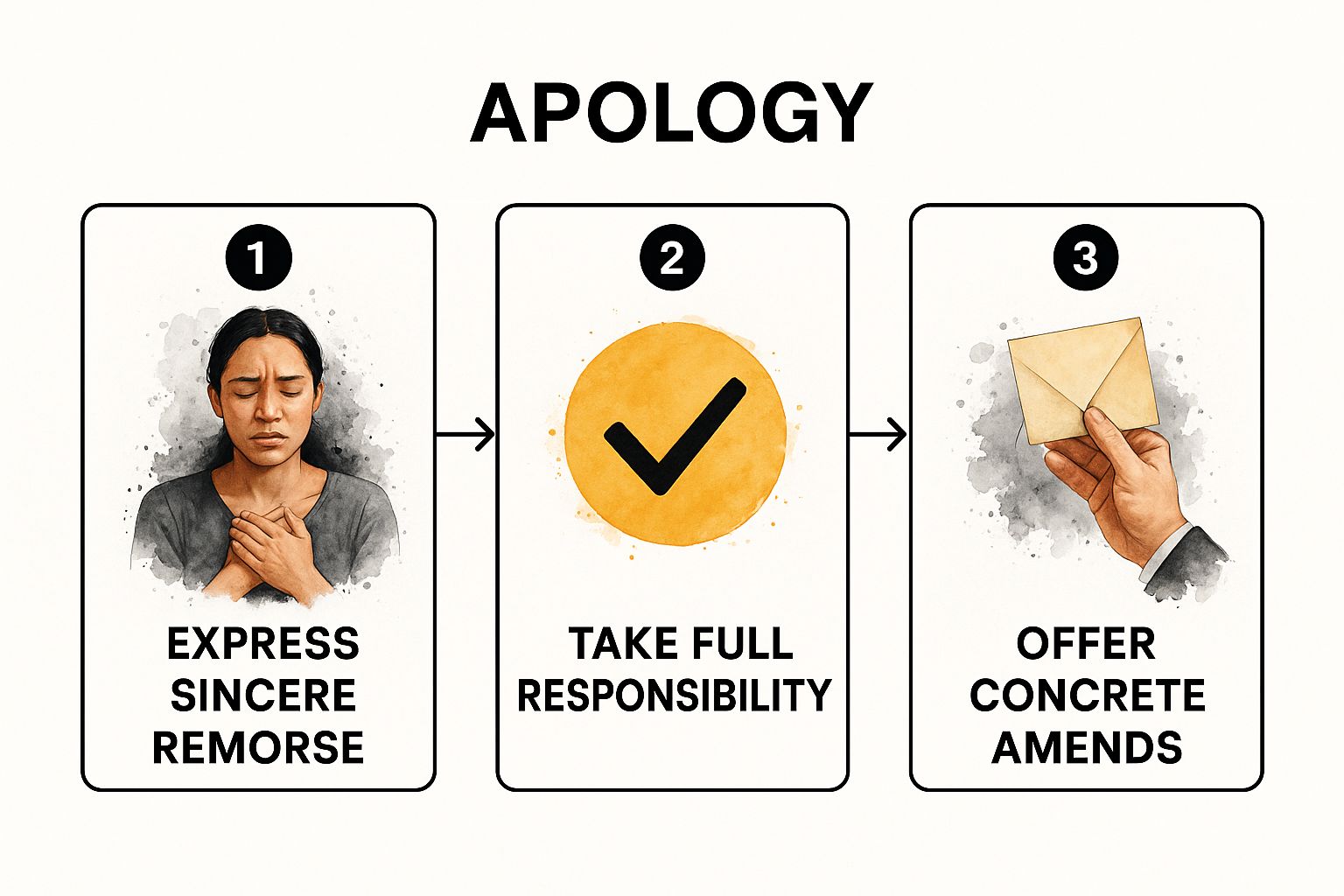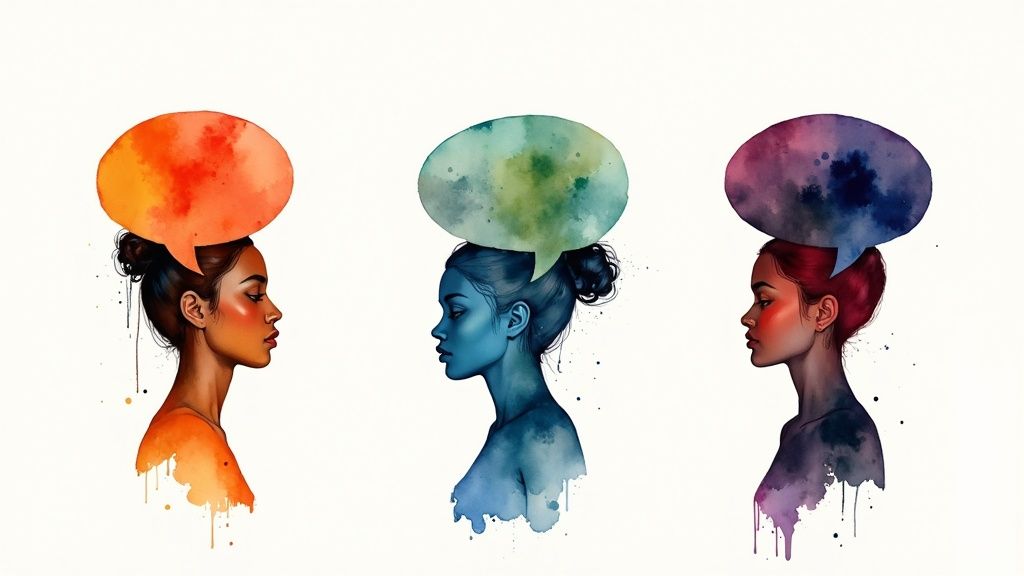To truly apologize, you have to do more than just say the words. It’s about taking full responsibility for what you did, showing you genuinely feel bad, and making it clear you’re going to change. We've all been on the receiving end of a fake "sorry" designed to just end a fight, and we know how hollow that feels. A real apology is about mending the connection.
Why a Real Apology Is More Than Just Words

Before we get into the "how-to," let’s talk about why this matters so much. A genuine apology isn't about admitting you lost an argument or just trying to smooth things over. Think of it as a powerful tool for rebuilding the trust that got damaged. It shows the other person you respect them and their feelings.
The difference between a heartfelt apology and a forced one can be the turning point that decides if a relationship heals or breaks down even more. A grudging "sorry" just makes the other person feel dismissed and unheard, often doing more damage than the original offense.
A real apology, on the other hand, shifts the focus entirely onto their feelings, not your need to get out of the doghouse.
The Heart of a Sincere Apology
So, what makes an apology actually work? It boils down to a mix of vulnerability and a concrete promise to do better. A good apology makes the other person feel seen and validated, showing them you’ve actually thought about what you did.
It really comes down to a few key things:
- Pinpointing the specific hurt you caused. This proves you were listening and you get why they’re upset.
- Showing real empathy. You need to try and put yourself in their shoes and truly feel the weight of their pain.
- Committing to change. This is the big one. Your words need to be backed up by actions down the line.
Research actually shows that when people apologize willingly, they are seen as more sincere and are more easily forgiven. It’s a powerful way to repair a relationship.
An apology is the superglue of life. It can repair just about anything. — Lynn Johnston
When you see it this way, apologizing stops being a moment of weakness and becomes an incredible act of strength. It’s about acknowledging that words alone are not enough to fix what was broken. The real goal is to mend the bond between you, and that requires your actions to match your words long after you’ve said you’re sorry.
The 6 Elements of a Sincere Apology
A real apology is so much more than just mumbling, "I'm sorry." If you really want to learn how to apologize and have it mean something, you have to understand what goes into it. Breaking it down into a few key parts takes the guesswork out and helps you say something that truly lands.
Think of a heartfelt apology less like a single sentence and more like a conversation built on 6 key pillars. Each one tackles a different part of the hurt you caused, showing the other person you’ve genuinely thought about your actions and the fallout. This approach makes sure you cover all your bases, from owning the mistake to rebuilding what was broken.
1. Express Genuine Remorse and Take Full Ownership
First things first: you have to state your regret, plain and simple. No excuses. Phrases like "I'm sorry, but…" or the classic "I'm sorry if you felt…" are apology-killers. They immediately water down your words and shift the blame.
Instead, keep the focus squarely on your actions and the impact they had.
For example, don't say, "I'm sorry if my comment came off as rude." A much better approach is: "I am truly sorry for what I said earlier. It was insensitive, and I deeply regret hurting you." See the difference? You're taking complete ownership of both the action and the outcome.
This infographic lays out the basic flow of a meaningful apology, starting with that crucial foundation of remorse and responsibility before you can even think about moving toward repair.

This visual shows how an apology has to be a process. It moves from an internal feeling of regret to the external actions of making things right.
2. Explain Without Justifying and Show You Get It
After you’ve owned it, it can be helpful to offer a little context for your actions—but tread very carefully here. The goal is to explain your mindset, not to justify your behavior. You want them to understand where you were coming from without making it sound like an excuse for the pain you caused.
A good way to handle this is to frame it with accountability. "I was really stressed about work, but that is no excuse for how I acted. I never should have taken it out on you." This shows you've reflected on your behavior while keeping the responsibility on your shoulders.
Then, immediately follow up by showing some empathy for how they must be feeling.
“I can only imagine how frustrating that must have been for you. You deserved to be treated with respect, and I completely failed to do that.”
This validation is absolutely critical. It shows the other person you aren't just stuck in your own guilt; you're actively trying to understand the emotional damage from their side. This is often the turning point in mending things, as it builds a bridge from your experience to theirs. Honing these skills is a huge part of having effective communication in relationships.
It's easy to fall into old habits, using language that sounds like an apology but is really just a way to deflect blame. The table below highlights the key differences between a sincere apology and a non-apology trap.
Elements of a Sincere Apology vs. a Non-Apology
| Component | Sincere Approach (Do This) | Non-Apology Trap (Avoid This) |
|---|---|---|
| Taking Responsibility | "I was wrong for…" | "I'm sorry if you felt…" |
| Acknowledging Impact | "I know that my actions hurt you." | "It wasn't my intention to…" |
| Expressing Regret | "I deeply regret what I did." | "I guess I should apologize for…" |
| Explaining vs. Justifying | "There’s no excuse, but I was feeling…" | "I'm sorry, but you have to understand…" |
| Committing to Change | "I will work on [specific action] to avoid this." | "I'll try not to do it again." |
Recognizing these patterns in your own speech is the first step toward crafting apologies that actually heal, rather than cause more frustration.
3. Offer to Make Amends and Ask for Forgiveness
Finally, a sincere apology isn't just about words; it's about a commitment to action. You need to offer a concrete way to make things right or to ensure the mistake won't be repeated. This could be anything from replacing something you broke to promising to be more present and put your phone away during conversations.
Once you’ve done that, then—and only then—can you ask for forgiveness. The key is to ask without expectation. You have to give them the space and time to process their feelings on their own terms.
End with something like, "I truly hope you can forgive me." This simple phrase acknowledges that forgiveness is their choice to give, not your right to demand.
How Culture and Generation Shape Apologies

Knowing how to deliver a heartfelt apology isn’t a universal skill. What works wonders with your best friend might completely fall flat with your grandparent or a colleague from another country. That's because the unwritten rules of saying "sorry" are deeply tangled up in our cultural backgrounds and even our generation.
In many Western countries, people tend to value a direct, explicit apology. They expect to hear the actual words, "I'm sorry," followed by a clear admission of what you did wrong. Anything less can come across as evasive or insincere.
But that's not the only way. In many Eastern cultures, a more indirect approach is often the norm. The priority is preserving harmony and allowing everyone to "save face." An apology might be communicated through thoughtful actions, specific gestures, or careful language rather than a blunt admission of guilt, which could cause embarrassment for both parties.
Navigating Generational Divides
It’s not just about where you're from; it's also about when you're from. You've probably noticed that younger people sometimes apologize for things that are completely out of their hands—like bad weather or a slow elevator.
This isn’t just a random quirk. Research actually backs this up, showing that younger Americans are way more likely to apologize for things they have no control over. A surprising 24% say they do it every single day. For them, it's often a way to show empathy and connect with others, even if older generations might find it a bit odd or unnecessary. You can dig into the numbers yourself in this YouGov poll analysis.
Understanding these nuances is crucial. A sincere apology requires you to consider the other person's perspective, and that includes their cultural and generational expectations for what "sorry" should look and sound like.
To make sure your apology truly connects, take a moment to consider these factors:
- Relationship Context: Are you talking to a close friend or your boss? The level of formality you use can change everything.
- Cultural Norms: If you’re interacting with someone from a different background, pause and think about their typical communication style.
- Age and Experience: A younger person might appreciate an apology that validates their feelings, while someone older might put more weight on your plan to fix the problem.
By tailoring your approach, you're not just saying sorry—you're showing a deeper level of respect and making sure your genuine intentions come through loud and clear.
Delivering Your Apology for Maximum Impact
How you say you’re sorry can be just as important as the words you choose. I've seen beautifully crafted apologies fall completely flat because the delivery was off. The right words get lost if the timing is terrible, the setting feels unsafe, or your body language is screaming that you'd rather be anywhere else.
Timing really is everything here. Don't ambush someone with a heartfelt apology when they're rushing out the door or visibly stressed about something else. A simple, "Is now a good time to talk about what happened?" shows respect for their schedule and signals that this conversation deserves their full attention.
Find a quiet, private place where you can both speak openly without an audience or constant interruptions. This isn't a performance; it's about connection and repair.
Choosing Your Method and Mindset
Whenever possible, an in-person apology is the gold standard. So much of what makes an apology feel sincere comes through in non-verbal cues—things like genuine eye contact and a calm, open tone of voice.
Of course, life happens. For smaller missteps or when you're separated by distance, a thoughtful message or a phone call can work. But for anything significant, a face-to-face conversation shows you aren’t hiding and are willing to be vulnerable.
Your physical presence speaks volumes before you even say a word. Resist the urge to cross your arms or stare at the floor, which can come across as defensive or dismissive. Instead, try to maintain gentle eye contact and keep your posture open and relaxed. This shows you're receptive to what they have to say. Learning to navigate these moments is a huge part of learning how to handle conflict in relationships in a healthy way.
Remember, the goal of your delivery is to create an environment where your sincere apology can be truly heard and felt. Your approach can either build a bridge or reinforce a wall.
Ultimately, your delivery should be calm and grounded, not buzzing with nervous energy. You're there to take responsibility, and a steady presence makes it far more likely that your apology will land well. Your delivery is what turns your words into a meaningful, healing action.
Common Apology Mistakes to Avoid
Even when your heart is in the right place, it’s surprisingly easy to fall into a few common apology traps that can completely derail your message. Knowing how to give a real, sincere apology is just as much about knowing what not to say.
The classic blunder? The “I’m sorry, but…” It’s a phrase that instantly negates everything that came before it. This little word turns your apology into an excuse, shifting the blame and basically telling the other person that your reasons are more important than their feelings.
Another major pitfall is making the apology all about you. When you say things like, "I feel so terrible about this," you’re hijacking the moment and forcing the person you hurt to comfort you. A genuine apology needs to stay focused on their experience and the impact of your actions.
The Non-Apology Apology
This is where so many apologies go wrong, and it's a huge reason they fail to actually mend anything. It’s a challenge that’s reflected in broader trends, too. Nearly half of Americans (48%) admit their apologies are sincere only sometimes or rarely. That statistic really highlights just how tricky it can be to get this right. You can read more about it in this study on apology habits.
The goal is to validate their experience, not to defend your own. An apology that minimizes their feelings or sidesteps responsibility isn't an apology at all—it's just a defense disguised as one.
To steer clear of these mistakes, stick to clear, unconditional language. For example, instead of saying, "I'm sorry you felt that way," try, "I am sorry that my actions made you feel that way."
See the difference? The first version is dismissive and almost implies their feelings are an overreaction. The second one takes ownership and directly links your behavior to their pain. That’s the key.
What to Do After You Say You Are Sorry

Delivering a sincere apology is the starting line, not the finish. The real work actually begins after the words "I'm sorry" have been said. Your follow-through is what proves your apology was genuine and not just a quick fix to end an uncomfortable conversation.
From here on out, your actions have to line up with your promise to do better. This is the part that shows you’ve truly understood how your behavior landed. It’s less about grand gestures and more about consistent, thoughtful changes over time.
Let Your Actions Speak Louder
The most critical step immediately after an apology is to give the other person the space they need. Don't pressure them for instant forgiveness or expect things to snap right back to normal. Healing happens on their timeline, not yours.
Be prepared to listen more if they want to talk again. They might need to express their hurt several times to feel completely heard, and your patient presence shows you're committed to making things right. This period of rebuilding can be a long road; if you are looking for guidance, our article on https://poke-match.com/how-to-rebuild-trust-after-betrayal/ can offer some valuable insights.
True amends are not a one-time payment but a long-term investment in changed behavior. Your consistency is the currency that rebuilds trust.
Ultimately, your changed behavior is the most powerful part of any apology. Beyond the words, establishing clear expectations and setting healthy boundaries can prevent future misunderstandings and create a much stronger relationship.
Remember that trust isn't rebuilt in a single moment. It's earned back slowly, through countless small actions that prove your apology was more than just words—it was a promise.
At Poke Match, we provide the insights and tools you need to build stronger, healthier connections. Explore our expert advice to navigate your relationship journey with confidence. Learn more at https://poke-match.com.
